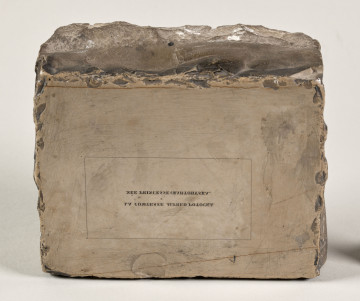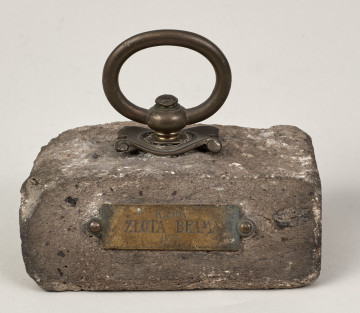
Paperweight
XIX century
Castle Museum in Łańcut
Part of the collection: Broń, instrumenty, varia
Human memory is unreliable, it is better to write down your thoughts so that they do not fly away. Writing is an art that is one of the milestones of human civilization.
All you need to write is a blank sheet of paper, a pen, ink (more and more often replaced by word processors, mice, etc.) and you can create another national epic. To make it not too easy, the ink stains the sheets of paper, stains the fingers, but tissue paper can remedy this. Once we have dealt with the ink and stains, we sit down and "pour" our thoughts onto paper. We're sitting, we're writing with enthusiasm, and then someone walks in the room, opens the door, opens the window, and this treacherous wind blows the written and unwritten pages to the floor, mixing everything up. The poor creator has to pick everything up, often on his knees, and his back hurts from sitting. When he has already collected the pages, it turns out that they are mixed, and they were forgotten to be numbered and, as if to make matters worse, a few pages were crumpled during the collection and in fact they should be rewritten. Finally, we manage to put the written pages in order and we sit down to continue our work, and then someone comes in on an urgent matter, someone opens the second window and again we have confetti from our written pages and we start collecting our written "golden thoughts" from the beginning. After a few such visits, we forget our own thoughts, discouragement creeps in, and because of such a small zephyr, some "epoch-making" work may not be created. And yet it was enough (with the exception of locking the doors and windows) to hold the blank and written pages with some heavy object, but not so heavy as to destroy the sheets of paper. Such an object is a paperweight, which is sometimes a small work of art in the form of figurines, plaques made of alabaster or glass, or other materials that are pleasing to the eye. They can also be very simple elements, such as various types of stones collected during trips from places sentimentally close to the collectors or related to the history of family or country. In this way, the paperweight became an indispensable desk equipment next to the inkwell, pounce pot, tissue paper, pen holder, lamp, and just like them, it took on different forms and shapes depending on the fashion prevailing in art at a given period. Paperweights, thanks to their form/shape and the material they are made of, complement the décor of the desk – those made of wood evoke the impression of warmth, those made of metal, especially precious metals, add majesty, and those made of glass or crystal, thanks to reflections, give the character of ephemerality like written thoughts. The most ordinary ones in the form of stones remind us of the places we have been to. They can also remind us of past centuries and events that constitute our history and heritage.
The discussed paperweights from the collection of the Museum – Castle in Łańcut, come from the collection of the Potocki family, belong to the second category and were brought from places currently outside the country. One of such paperweights, inv. no. 4486MŁ, is made of stone, in the shape of a lying triangle, has a round brass handle mounted on a stylized cartouche. Currently, the paperweight does not have a brass plate with the inscription "Zamek birżański" (“Birże Castle”), only traces of attaching the plate to the stone remain.
Birże is located in the Trakai Voivodeship (Lithuania), and the castle built there was part of the defence system of the northern border of the Grand Duchy of Lithuania. The castle (most probably wooden) was so spacious that in 1415 Władysław Jagiełło stayed there. In the second half of the 15th century, the owner of the village was the secretary of Kazimierz Jagielończyk, Grzegorz Friedkomis. After the death of the royal secretary (childless), the Birže estate passed to his wife's relatives and in 1492 it was the property of the Radziwiłł family, remaining in the hands of this powerful family until the beginning of the 19th century. In the first half of the 16th century, the new owners built a new residence and surrounded it with bastion fortifications on the Dutch model. These works were started by Mikołaj Radziwiłł, known as "Rudy", who added "Pan na Birżach i Dubinkach" (“the ruler of Birże and Dubinki”) to his titles, and was continued by his brother Krzysztof Mikołaj called "Piorun" and his son Krzysztof Radziwiłł. Despite new fortifications, in 1625 the castle was conquered by the Swedish army under the command of Gustavus Adolphus, who established his headquarters in Birże. The Swedes, leaving the Birżę Castle (on the provisions of the treaty), stripped it of artillery, taking away 60 cannons, plundered the local treasury and partially destroyed the fortification system and the castle itself. Bearing in mind the military significance of the castle, Krzysztof Radziwiłł immediately after the departure of the Swedes began the reconstruction and expansion of the fortifications and the castle. The significance of the castle in Birże was so great, not only for the Radziwiłł family, but also for the Commonwealth of Both Nations, that its reconstruction was financed from public money by the decision of the Sejm. It was worth noting the participation of the artilleryman Gotthard Platter in the design works, thanks to which the defensive values of the castle were increased. Over the next few years, the lords of Birże were the Radziwiłł, known from history, including Janusz and Bogusław Radziwiłł (described so suggestively in "The Deluge"). The latter transformed the Birże castle in 1660 into a "palazzo in fortezze" after regaining it, the work lasted quite a long time, because for treason and supporting Sweden for some time Bogusław's property was confiscated. Other well-known owners of Birże were Michał Kazimierz called "Rybeńko", his son Karol called "Mr. Lover". At the end of its existence the castle was the meeting place of Augustus II the Strong and the Tsar of Russia Peter I (March 9, 1701). During the next war with Sweden in 1704, after a short defense, the castle was conquered by the Swedish army commanded by Adam Ludwig Loewenhaupt. By his order, the fortifications and the castle were destroyed. For more than 100 years, Birże remained in the hands of the Radziwiłł family, and the last owner of this family was Dominik Hieronim Radziwiłł. In 1805, the authorities of Tsarist Russia took over Dominik's estates in the Russian partition (for the reason of non-repayment of the loan) and sold them cheaply to the representatives of the Tyszkiewicz family. Birże remained in the hands of the Tyszkiewicz family until the outbreak of World War II, a new palace was built in the 1850s, becoming the seat of the family for the following years. Thanks to such inconspicuous objects as the described paperweight, the memory of people and places related to the history of Poland is preserved, especially that as a result of many wars, these places are now outside the country.
Przemysław Kucia
Author / creator
Object type
pamiątki
Material
stone
Creation / finding place
Owner
Muzeum - Zamek w Łańcucie
Identification number
Location / status

XIX century
Castle Museum in Łańcut

XIX century
Castle Museum in Łańcut

XIX century
Castle Museum in Łańcut
DISCOVER this TOPIC
National Museum in Lublin
DISCOVER this PATH
Educational path